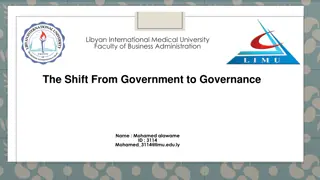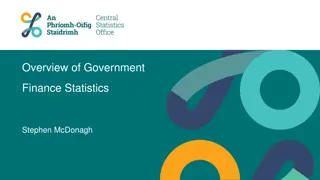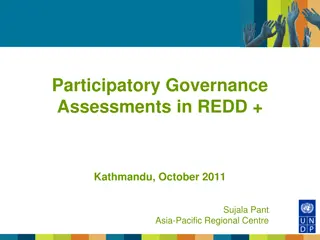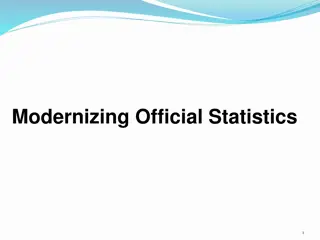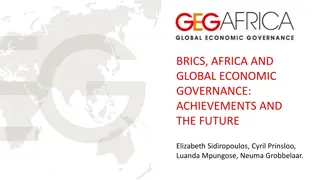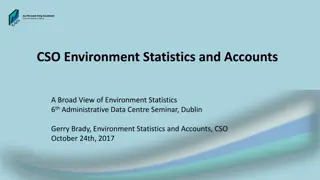Understanding the Essential Role of Government Finance Statistics and EDP Data in Economic Governance
DG ECFIN plays a crucial role in economic surveillance, utilizing government finance statistics and EDP data for tasks such as monitoring deficit and debt levels, implementing the Stability and Growth Pact, and formulating country-specific recommendations in fiscal policy. The collaboration between Eurostat and DG ECFIN is key in providing a comprehensive assessment of budgetary policies and macroeconomic forecasts to ensure financial stability and compliance with EU regulations.
Download Presentation

Please find below an Image/Link to download the presentation.
The content on the website is provided AS IS for your information and personal use only. It may not be sold, licensed, or shared on other websites without obtaining consent from the author. Download presentation by click this link. If you encounter any issues during the download, it is possible that the publisher has removed the file from their server.
E N D
Presentation Transcript
Using government finance statistics and EDP data by DG ECFIN Seminar on Government Finance Statistics Ingrid Toming Antonino Barbera Mazzola European Commission Directorate General for Economic and Financial Affairs (DG ECFIN) 27 April 2022
DG ECFIN has multiple tasks Economic surveillance: Stability and Growth Pact, Macroeconomic Imbalances Procedure Next Generation EU: Recovery & Resilience Facility, SURE European Semester Financial assistance programmes and post- programme surveillance Analytical work, briefings etc.
SGP: Preventive and corrective arm Based on Art 121 TFEU Coordination of economic policies Multilateral surveillance: possibility to issue warnings and recommendations Possibility to adopt detailed rules for surveillance procedure Based on Art 126 TFEU Monitoring of deficit and debt levels Deficit < 3% of GDP, debt < 60% of GDP Excessive Deficit Procedure (EDP) Preventive arm = Regulation (EU) 1466/97 Corrective arm = Regulation (EU) 1467/97
Stability and Growth Pact (SGP) DG ECFIN and Eurostat have a shared role in the implementation of the Stability and Growth Pact Eurostat provides outcome data underlying the assessment (backward-looking element) DG ECFIN provides forecasts (forward-looking element) and the assessment of budgetary policies General escape clause Economic governance review
The essential role of GFS/EDP data for SGP DG ECFIN uses national accounts data to make macroeconomic forecast and GFS data to make fiscal forecast - ECFIN calculates structural balances (cyclically adjusted balances net of one-off and temporary measures) Cut-off date of spring and autumn forecasts is typically aligned with validation of EDP notifications
The essential role of GFS/EDP data for SGP (continued) Based on EDP notifications and DG ECFIN forecast: - EDP steps are proposed (opening new EDPs, abrogation, "stepping-up") - Compliance with preventive arm requirements is checked - Country-specific recommendations in fiscal policy area are formulated (in spring) - Opinions on draft budgetary plans are formulated (in autumn, for the euro area member states) - Warnings are issued, when necessary
Macroeconomic Imbalances Procedure (MIP) Importance of imbalances additionally to fiscal Alert system: set of economic indicators to be monitored (Scoreboard) Takes into account competitiveness, external financial position, sectoral financial positions, housing sector, financial sector etc. Both preventive and corrective (EIP) actions
Next Generation EU / RRF Significant and temporary increase in EU grants and loans; funding to be repaid by the EU over the long term RRF grants provide fiscal stimulus which is not visible in the general government balance Need for new data to monitor the economic impact of EU funded policies Expanding the scope of reporting on transactions between EU Institutions and Member States through ESA 2010 mid-term review Temporary reporting on RRF flows through a dedicated table
Financial assistance programmes In the past, financial assistance programmes in Ireland, Greece, Spain, Latvia, Hungary, Portugal, Romania and Cyprus post-programme surveillance still ongoing in Cyprus, Ireland, Greece, Portugal, Spain Operational monitoring and targets under the programmes were are often based on cash data / national methodology, while ensuring consistency with EDP and other processes importance of reconciliation tables, EDP inventories and other information
Analytical work, briefings etc. DG ECFIN conducts analysis in several areas Briefings, responding to questions by MEPs and citizens DG ECFIN maintains several databases used by policymakers and researchers AMECO, business and consumer surveys, fiscal governance, taxation reforms, tax and benefits indicators,
Forecast GFS data to analyse past trends and build baseline Some key variables: -Revenue: Taxes on production and imports (D.2r); Taxes on income and wealth (D.5r); Social contribution (D.61r); Sales (P.11+P.12+P.131); Capital transfers (D.9r); etc. -Expenditure: Intermediate consumption (P.2); Compensation of employees (D.1); Interest (D.41); Social benefits (D.62); Subsidies (D.3p); Gross fixed capital formation (P.51g); etc. NB: complete forecast file is more granular
Baseline Example: COVID measures Government Finance Statistics - Annual 2016 to 2021 (April 2022 Results) CSO
Fiscal surveillance Not only assessment of 3% and 60% limits GFS data are also used in other legs of ex-post assessment, e.g. to compute the nominal growth rate of government expenditure, net of discretionary revenue measures and one-offs and compare it with a country s medium-term potential economic growth rate.
Thank you for your attention! Further info: http://ec.europa.eu/economy_finance/index_en.htm







